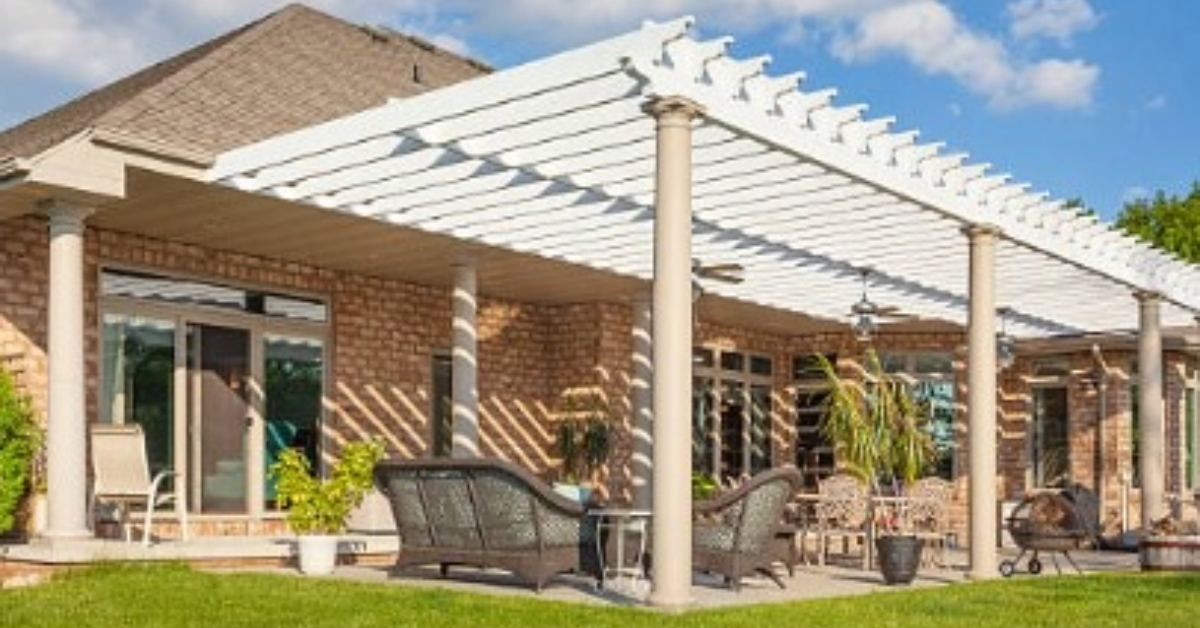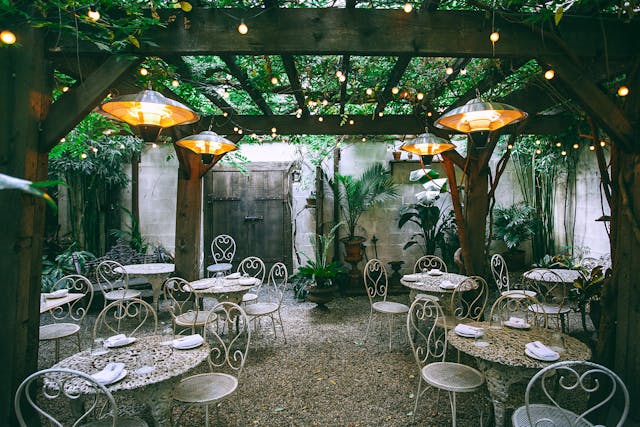
There’s no doubt that pergolas are a stylish addition to your outdoor space, and a great solution when it comes to offering shade, aesthetic appeal, and functionality.
However, if you live in an area prone to high winds, it’s essential to choose a high end pergola design that can withstand gusty conditions. When considering your purchasing options, you need to be mindful that a wind-resistant pergola is not just a luxury, it’s a necessity to ensure durability, safety, and long-term enjoyment of your structure.
What sort of things should you look for when purchasing a pergola? Let’s explore the key factors influencing a pergola’s wind resistance, take a look at various materials and designs suitable for windy areas, and review some professional tips for installation and maintenance to help you achieve the strength and durability needed.
Why Wind Resistance Matters for Pergolas
It’s fair to say that wind can be a highly destructive force, especially in regions prone to hurricanes, storms, or strong seasonal gusts. If you have a pergola that is not designed to handle such stresses it can lead to costly repairs. It can also create avoidable safety hazards, and potential damage to surrounding property.
What are the key challenges that wind poses to your pergola?
Primarily, structural integrity is a key consideration. Wind exerts a certain level of pressure on a pergola, potentially causing weak materials to break and putting poorly constructed structures under intense pressure.
In particular, areas to focus on include things like anchoring issues and the potential for components to break. Uplift forces can soon dislodge inadequately secured structures, and lightweight or flimsy materials may crack, bend, or break under pressure.
These are compelling reasons why investing in a wind-resistant pergola not only boosts safety, but also improves your prospect of enjoying longevity and value for your investment.
Main Features of Wind-Resistant Pergolas
Before exploring specific types of suitable pergolas, let’s understand the essential characteristics that make a pergola wind-resistant.
It is important that your pergola is made from strong materials. The materials used play a significant role in a pergola’s wind resistance. Options like aluminum, steel, and reinforced wood are sturdier and more resilient compared to materials like plastic or untreated wood.
You also need to be sure that your chosen pergola structure boasts sturdy anchoring systems. The bottom line is that the foundation of your pergola is critical. Proper anchoring using concrete footings, ground screws, or steel brackets ensures that the structure remains secure even in high winds.
Look for a pergola that has a good aerodynamic design. Pergolas with slatted roofs or adjustable louvers allow wind to pass through, reducing resistance. Solid-roof pergolas, while offering more shade, are often less wind-friendly unless specifically engineered for such conditions.
It can also make a substantial difference if your pergola has reinforced joints and connections. A well-designed pergola usually features reinforced joints and brackets to prevent collapse under pressure.
Choosing the Right Types of Pergola That Are Best Suited for Windy Areas
Aluminum Pergolas –
Arguably, a prime contender would be aluminum pergolas. They are ideal for a number of valid reasons. Lightweight yet strong, aluminum pergolas are corrosion-resistant and durable.
In addition, they are often designed with sleek, modern aesthetics and feature aerodynamic elements like slatted roofs, which help reduce the threat of wind damage.
Aluminum pergolas tend to have a variety of design features that are specifically aimed at reducing the threat of wind damage, especially when you choose a high spec model.
These pergolas can incorporate adjustable louvers or open slats, reducing wind load. Also, high-grade aluminum structures are often tested for wind resistance and can withstand significant gusts.
Steel Pergolas –
As you would expect, steel can be considered one of the strongest materials available for pergolas. In particular, powder-coated steel offers excellent weather resistance, making it a durable choice for high-wind areas.
As they tend to be heavier than their aluminum counterparts, steel pergolas are less likely to shift or lift in strong winds. Not only that, steel structures can support larger spans and heavier roofing materials, which may be ideal if you need a larger pergola design to fill your space.
Make sure that if you choose a steel pergola, it is treated for rust resistance, especially in humid or coastal areas.
Wooden Pergolas –
If you are thinking about a wooden pergola it would need to be a reinforced design. In general, wood pergolas offer a classic, natural look while being structurally robust when reinforced.
You will need to opt for pressure-treated wood or hardwoods like cedar and redwood, as these provide durability and a certain level of protection against the elements.
A wooden pergola can be suitable as long as you have thicker posts and beams that add stability. In addition, proper anchoring and bracing techniques are needed, such as cross-beams or knee braces, as they enhance wind resistance.
Bear in mind that wooden pergolas need regular maintenance compared to other manufactured options. This is required to prevent rot, warping, or insect damage, which can compromise wind resistance.
Vinyl Pergolas –
Again, vinyl pergolas are a potential option, provided you look at reinforcing the structure, especially if you live in a windy area.
Vinyl pergolas are low-maintenance and offer a clean, modern look. Reinforced vinyl comes with internal aluminum or steel, which improves wind resistance significantly.
All things considered, you would have to say that pure vinyl pergolas, without reinforcement, are not recommended for high-wind zones.
Adjustable or Retractable Roof Pergolas Are Another Viable Option
These pergolas feature roofs that can open or retract to help reduce wind resistance. Understandably, this sort of flexibility makes this type of pergola popular in areas with variable weather conditions.
The ability to close or open slats can significantly reduce the threat of damage from wind pressure.
Often made with durable materials like aluminum or steel for enhanced stability, retractable pergolas are perfect for properties where both shade and wind management are priorities.

Design Tips to Improve Wind Resistance
There are several ways to minimize the threat of wind damage. A good starting point would be to choose a low profile design. Having a lower height reduces the surface area exposed to wind, making the structure more stable.
Be sure to incorporate wind-permeable elements. Opt for open designs such as lattice panels or slatted roofs that allow wind to pass through, as this helps with minimizing resistance.
When it comes to securing your pergolas, you will need secure anchoring points. Use deep concrete footings or heavy-duty ground screws to anchor the pergola securely.
Add braces and reinforcements, if needed. Diagonal braces or cross-beams between posts add rigidity and reduce wobbling under stress.
Finally, think about positioning. Try to install the pergola near natural windbreaks like walls, fences, or dense landscaping to reduce wind exposure.
If you incorporate these features and recommendations into your pergola design it will help you to manage the potential threat of wind damage. If you are not sure, hiring an experienced professional can be a smart move. This ensures the pergola is properly secured and complies with local building codes for wind resistance.
Selecting a wind-resistant pergola requires careful consideration of materials, design, and installation techniques. By following these suggestions, you can enjoy a pergola that stands strong against the elements and will give you years of enjoyment.
I'm so excited to tackle all my home improvement projects! From plumbing to DIY and cleaning - I'm ready to get down to work! #homerepair #homecleaning #plumbing #diy #fixerupper #realestate #renovation #interiordesign #farmhouse #diy #homedecor #hgtv #home #farmhousedecor #modernfarmhouse #farmhousestyle #fixerupperstyle #fixandflip #homerenovation #realestateinvesting #beforeandafter #homesweethome #remodel #realestateinvestor #interior #realtor #joannagaines #flippinghouses #countryliving #design #homedesign #farmhouseinspired #investmentproperty #bhghome #renovationproject #farmhousekitchen #homeimprovement #farmhouseliving #cottagestyle #decor #realestateagent #magnoliahome #homeinspo #magnoliamarket #kitchendesign #dreamhome #shiplap #construction #houseflipping #investor #farmhousedesign #architecture #farmhousechic #homereno #rusticdecor #reno #kitchenremodel #webuyhouses #magnoliatable #rentalproperty #fixerupperinspired #newhome #interiors #homeremodel

